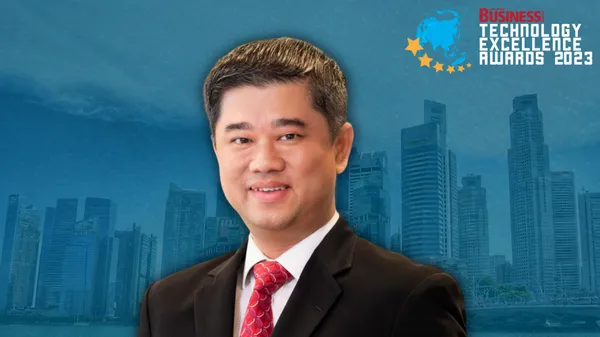
Sustainability capabilities, credentials ‘top attributes’ sought for future tech vendors: EY
This comes as ESG compliance is becoming increasingly important for tech companies.
Wai Keat Cheang is a Consulting partner at EY in Singapore, where he covers agile business transformation, post-merger integration, and end-to-end managed services consultation for IT and business processes for life sciences, health care, consumer goods, agribusiness, transportation and real estate clients.
He has vast experience in providing technology consulting services to numerous local and multinational corporations from the private and public sectors across the Asia-Pacific region.
Looking into Singapore’s tech industry for the past year, Cheang observed that the pace of digital transformation has accelerated substantially. He also noted the rise in the focus and importance of sustainability and environmental, social and governance (ESG) impact in recent years.
He added that sustainability capabilities and credentials are the top attributes organisations will be seeking in their technology vendors in the future.
“Companies in the tech sector need to look into embedding ESG principles into their corporate strategy and culture, and this needs to start from the top,” Cheang said.
As part of this year’s esteemed panel of judges for the SBR Technology Excellence Awards, the EY partner sat down with Singapore Business Review to discuss the significant progress the Singapore tech industry has made, the most common challenges tech companies face today, as well as incorporating ESG compliance in the tech landscape.
How has the Singapore technology landscape evolved in the past year? Are there any trends to watch out for?
As a result of the pandemic, the pace of digital transformation has accelerated substantially, both globally and in Singapore. Notably, the key digital transformation trend that will continue to take centre stage post-pandemic will be the acceleration of use cases for artificial intelligence (AI), cloud computing, the Internet of Things (IoT) and 5G.
AI is finding its way deeper into all aspects of life today with the rise of chatbots and virtual bots. AI not only improves efficiency, but it also frees up time for people to focus on innovation, offers opportunities to creatively combine technologies to create new ways of working, and augments decision-making by adding a layer of machine-driven data analysis. In fact, in the boardroom, CFOs are increasingly adopting AI in finance functions, especially for repetitive and routine tasks, as well as in strategic decision-making.
Cloud computing has not only played an integral role in ensuring business sustainability during remote working but has enhanced speed to market, agility and responsiveness. According to the EY Tech Horizon survey, most companies understand the importance of the cloud – it has been in the top two priorities in the 2020 and 2022 editions of the survey. Leaders are using the cloud to leverage more of the native Platform-as-a-Service capabilities, taking advantage of speed and agility to innovate where they could not have done so with traditional technologies, whilst reducing costs.
In terms of IoT and 5G, EY research has found that organisations are showing more interest in these emerging technologies, due to external factors, such as supply chain disruption, that are disrupting the business environment. Interestingly, the ESG considerations of 5G and IoT also weighed strongly in enterprises’ investment decisions. With enterprises’ 5G and IoT strategies increasingly oriented towards growth, this trend of 5G and IoT strategies adoption looks to continue.
With your experience in technology consulting services, what are the common issues that tech companies face? How do you think they should handle such problems?
The most common challenges that tech companies face today are the lack of innovation as well as agility in dealing with business disruptions, cybersecurity threats, regulatory compliance and talent management. However, companies can turn these challenges into opportunities with the right approach.
Lack of innovation: Tech companies that struggle to find new and innovative ways to improve their product or service offerings can consider investing in research and development or experimenting with platform ecosystems to disrupt the market. This can come in the form of collaboration with third parties who share common goals, to problem-solve and leverage emerging technologies to disrupt existing business models. Importantly, a culture of creativity and experimentation internally will be key to success.
Lack of agility: Since the pandemic, many organisations are recognising the importance of agility in dealing with sudden changes and evolving market conditions. For example, those companies that had been investing in emerging technologies and thrived on a culture of innovation were able to quickly find new ways of working and conducting business when movement restrictions were implemented. From this, companies should invest in scalable technologies and processes, develop agile methodologies, and foster a culture of continuous improvement and innovation.
Cybersecurity threats: Data security is a key element of every customer proposition, yet technology companies are often vulnerable to cyberattacks. To mitigate this risk, tech companies should implement robust cybersecurity measures, conduct regular vulnerability assessments, and update incident response plans. EY surveys have found that employees are one of the biggest cybersecurity vulnerabilities of organisations. Hence, regular employee training should be conducted to protect organisations against cybersecurity breaches.
Regulatory compliance: Like companies in highly-regulated sectors such as financial services, and health and life sciences, tech companies are also increasingly facing scrutiny from authorities, particularly in areas such as data privacy and security. For compliance, tech companies should seek to have a thorough understanding of relevant laws and regulations and develop policies and procedures that align with regulatory requirements. Regular internal audits should also be conducted to ensure compliance.
Talent acquisition and retention: Attracting and retaining top talent is another challenge faced by many companies, not just the tech sector. To this end, companies need to drive an agile and dynamic talent strategy in line with the business needs and adopt attractive compensation packages, redesign career frameworks and opportunities for career progression, and foster a positive and inclusive workplace culture and experiences.
What do you think is the importance of incorporating ESG compliance in the Singapore technology landscape? How can companies better adhere to this?
The focus on sustainability and ESG impact has been intensifying in recent years. Hence, ESG compliance is becoming increasingly important for tech companies. The EY Reimagining Industry Futures Study finds that sustainability capabilities and credentials are the top attributes that organisations will seek in their technology vendors in the future. Other studies have also found that companies that integrate ESG principles into their operations can enhance their long-term business and financial performance and reputation.
To do this, companies in the tech sector need to look into embedding ESG principles into their corporate strategy and culture, and this needs to start from the top. ESG leaders or chief sustainability officers should have a seat in the executive leadership or boardroom so they can champion ESG efforts from an organisational level – where clear ESG targets and goals are outlined and ESG metrics are integrated into performance evaluations and compensation structures.
There is also a need to conduct regular ESG risk assessments and audits to identify areas of improvement. Additionally, regular engagement with stakeholders such as customers, investors, and employees for feedback on their ESG efforts and identifying opportunities for improvement will be important. Finally, companies can also leverage technology to drive ESG compliance, where they leverage data analytics to track and measure their ESG performance, employ digital tools to reduce their environmental impact and invest in innovative solutions that promote sustainability and social responsibility.
What are the most important character traits and values that aspiring technology consultants must cultivate?
Some character traits and values that aspiring technology consultants should possess include:
Strong communication skills: Consultants need to be able to clearly explain complex technical concepts to clients who may not have a technical background. Good communication skills are essential for building trust and establishing a strong working relationship with clients.
Problem-solving skills: Consultants must be able to identify problems and develop effective solutions. They need to be analytical and have a systematic approach to problem-solving.
Adaptability: Technology is constantly evolving and the pace of technological changes and innovations happens rapidly. As such, consultants must be adaptive, flexible, and willing to learn new skills and technologies.
Attention to detail: Consultants must be attentive to details and be able to work with a high level of accuracy. They need to be able to spot errors and inconsistencies in data and codes.
Time management skills: Consultants often work on multiple projects at once, thus the ability to prioritise tasks and manage their time effectively is important.
Ethical behaviour: Consultants must act with integrity and always prioritise the best interests of their clients, avoiding conflicts of interest and maintaining confidentiality.
Teamwork: Consultants often work in teams with other consultants, developers, and project managers. They need to be able to collaborate effectively and contribute to a positive team environment.
Professionalism: Consultants must maintain a professional demeanour even when faced with difficult situations or challenging clients.
Business acumen: Consultants need to understand the business context in which they are operating, be able to align technical solutions with business objectives, and identify opportunities for growth and innovation.
By cultivating these character traits and values, aspiring technology consultants can build a successful and rewarding technology consulting career in the industry.
As a judge for this year’s SBR Technology Excellence Awards, what qualities are you looking for in this year’s entries?
With the rapid evolution of technology and disruption of the business landscape, achieving technological excellence is an ongoing journey. As a judge, I will be looking for entries that demonstrate a spirit of dynamism, innovation and sustainability.
The qualities of the winning entries should go beyond incremental changes and be forward-looking in transforming or creating new business models and channels, preparing organisations for the future digital and data-driven economy. Good use of data and AI to generate business and customer insights, and drive customer-first business strategy and decisions will be key. At the same time, they should demonstrate business effectiveness and impact in helping address a business issue and improving the top and bottom lines.



![SBR 5 Lorem Ipsum News 2 [8 May]](https://cmg-qa.s3.ap-southeast-1.amazonaws.com/s3fs-public/styles/exclusive_featured_article/public/2025-05/a_hand_pointing_to_a_futuristic_technology_5b87c9d0e3_3.png.webp?itok=M3Hf-9XR)
![SBR 4 Lorem Ipsum [8 May Top Stories]](https://cmg-qa.s3.ap-southeast-1.amazonaws.com/s3fs-public/styles/exclusive_featured_article/public/2025-05/a_hand_pointing_to_a_futuristic_technology_5b87c9d0e3_2.png.webp?itok=2m5Wl0MX)


![Exclusive three SBR 12 Lorem Ipsum [8 May]](https://cmg-qa.s3.ap-southeast-1.amazonaws.com/s3fs-public/styles/exclusive_featured_article/public/2025-05/a_hand_pointing_to_a_futuristic_technology_5b87c9d0e3_11.png.webp?itok=8kn_UIfA)
![SBR 3 Lorem Ipsum [ Exclusive 2]](https://cmg-qa.s3.ap-southeast-1.amazonaws.com/s3fs-public/styles/exclusive_featured_article/public/2025-05/a_hand_pointing_to_a_futuristic_technology_5b87c9d0e3_1.png.webp?itok=YCyjLegJ)
![SBR 2 Lorem Ipsum [8 May]](https://cmg-qa.s3.ap-southeast-1.amazonaws.com/s3fs-public/styles/exclusive_featured_article/public/2025-05/a_hand_pointing_to_a_futuristic_technology_5b87c9d0e3_0.png.webp?itok=_cKD-29o)

![Video [Event News]](https://cmg-qa.s3.ap-southeast-1.amazonaws.com/s3fs-public/styles/event_news_featured_article/public/2025-05/screenshot-2025-05-08-at-4.58.53-pm_0.png.webp?itok=Kud35sMs)
![Event News SBR 9 Lorem Ipsum [8 may]](https://cmg-qa.s3.ap-southeast-1.amazonaws.com/s3fs-public/styles/event_news_thumbnail/public/2025-05/a_hand_pointing_to_a_futuristic_technology_5b87c9d0e3_8.png.webp?itok=DTh_dbYp)
![Event News SBR 9 Lorem Ipsum [8 May]](https://cmg-qa.s3.ap-southeast-1.amazonaws.com/s3fs-public/styles/event_news_thumbnail/public/2025-05/a_hand_pointing_to_a_futuristic_technology_5b87c9d0e3_7.png.webp?itok=vzDAzb6V)
![Event News SBR 8 Lorem Ipsum [8 May]](https://cmg-qa.s3.ap-southeast-1.amazonaws.com/s3fs-public/styles/event_news_thumbnail/public/2025-05/a_hand_pointing_to_a_futuristic_technology_5b87c9d0e3_6.png.webp?itok=jvHFc4P6)
![Video [Event News]](https://cmg-qa.s3.ap-southeast-1.amazonaws.com/s3fs-public/styles/video_thumbnail/public/2025-05/screenshot-2025-05-08-at-4.58.53-pm_0.png.webp?itok=yZnI0YBb)
![Video 1 SBR [8 May]](https://cmg-qa.s3.ap-southeast-1.amazonaws.com/s3fs-public/styles/video_thumbnail/public/2025-05/screenshot-2025-05-08-at-4.58.53-pm.png.webp?itok=9AAeRz_k)

 Advertise
Advertise

